MGMT6011 - Strategic Management: A Detailed Case Study of Porsche
VerifiedAdded on 2023/06/11
|23
|4392
|220
Case Study
AI Summary
This case study provides a strategic management analysis of Porsche Company, examining its objectives, ownership structure, and the external and internal factors influencing its performance. It includes a PESTLE analysis, SWOT analysis, strategic group diagram, Porter's Five Forces framework, value chain analysis, and VRIO framework to assess Porsche's competitive advantages and disadvantages. The report identifies key sources of cost and differentiation advantage, such as brand equity, technology, and efficient global distribution. It concludes with recommendations for Porsche to enhance its strategic position and achieve sustainable growth in the automotive industry. Desklib provides this document as part of its collection of student-contributed assignments and study resources.
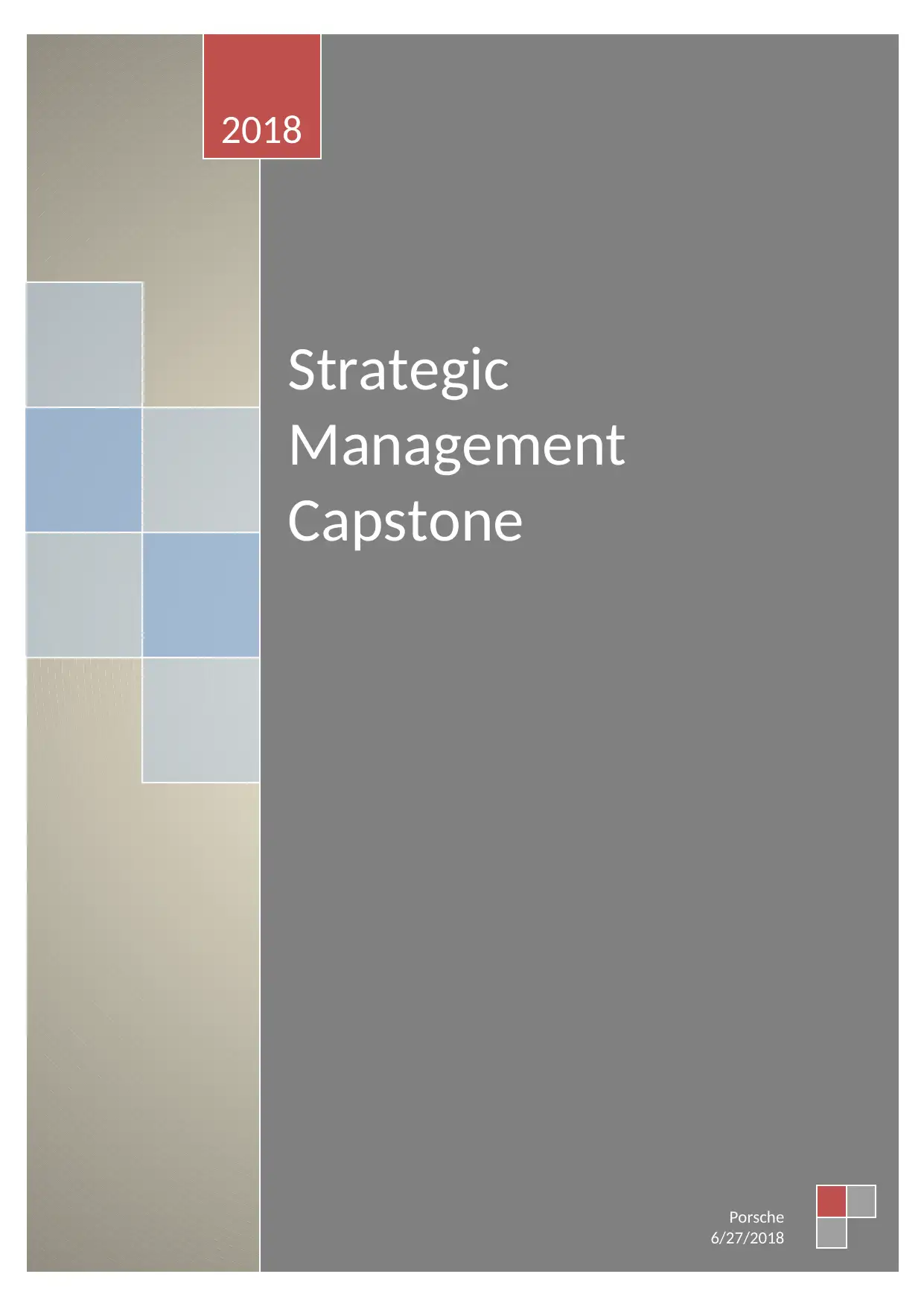
Strategic
Management
Capstone
2018
Porsche
6/27/2018
Management
Capstone
2018
Porsche
6/27/2018
Paraphrase This Document
Need a fresh take? Get an instant paraphrase of this document with our AI Paraphraser
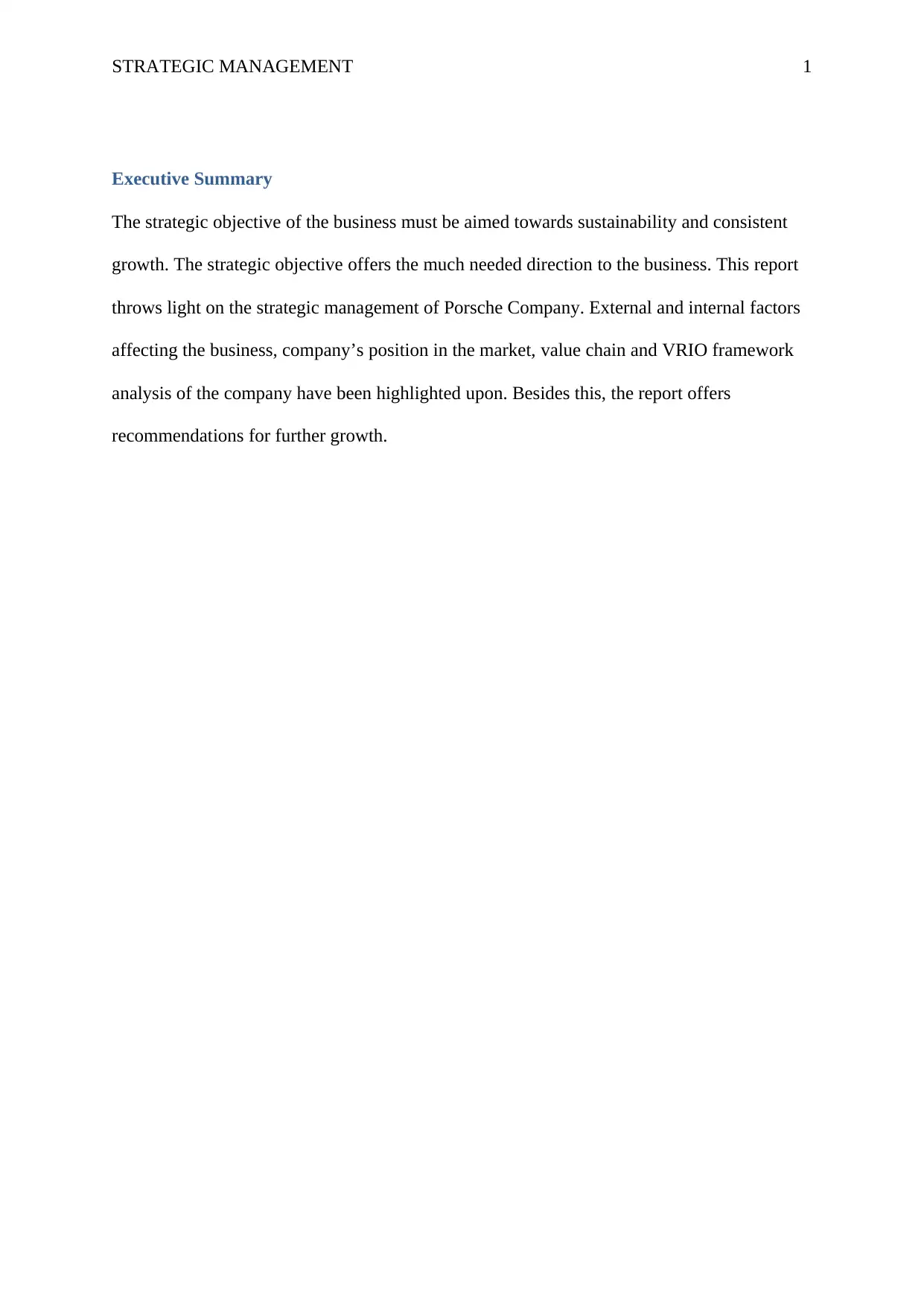
STRATEGIC MANAGEMENT 1
Executive Summary
The strategic objective of the business must be aimed towards sustainability and consistent
growth. The strategic objective offers the much needed direction to the business. This report
throws light on the strategic management of Porsche Company. External and internal factors
affecting the business, company’s position in the market, value chain and VRIO framework
analysis of the company have been highlighted upon. Besides this, the report offers
recommendations for further growth.
Executive Summary
The strategic objective of the business must be aimed towards sustainability and consistent
growth. The strategic objective offers the much needed direction to the business. This report
throws light on the strategic management of Porsche Company. External and internal factors
affecting the business, company’s position in the market, value chain and VRIO framework
analysis of the company have been highlighted upon. Besides this, the report offers
recommendations for further growth.
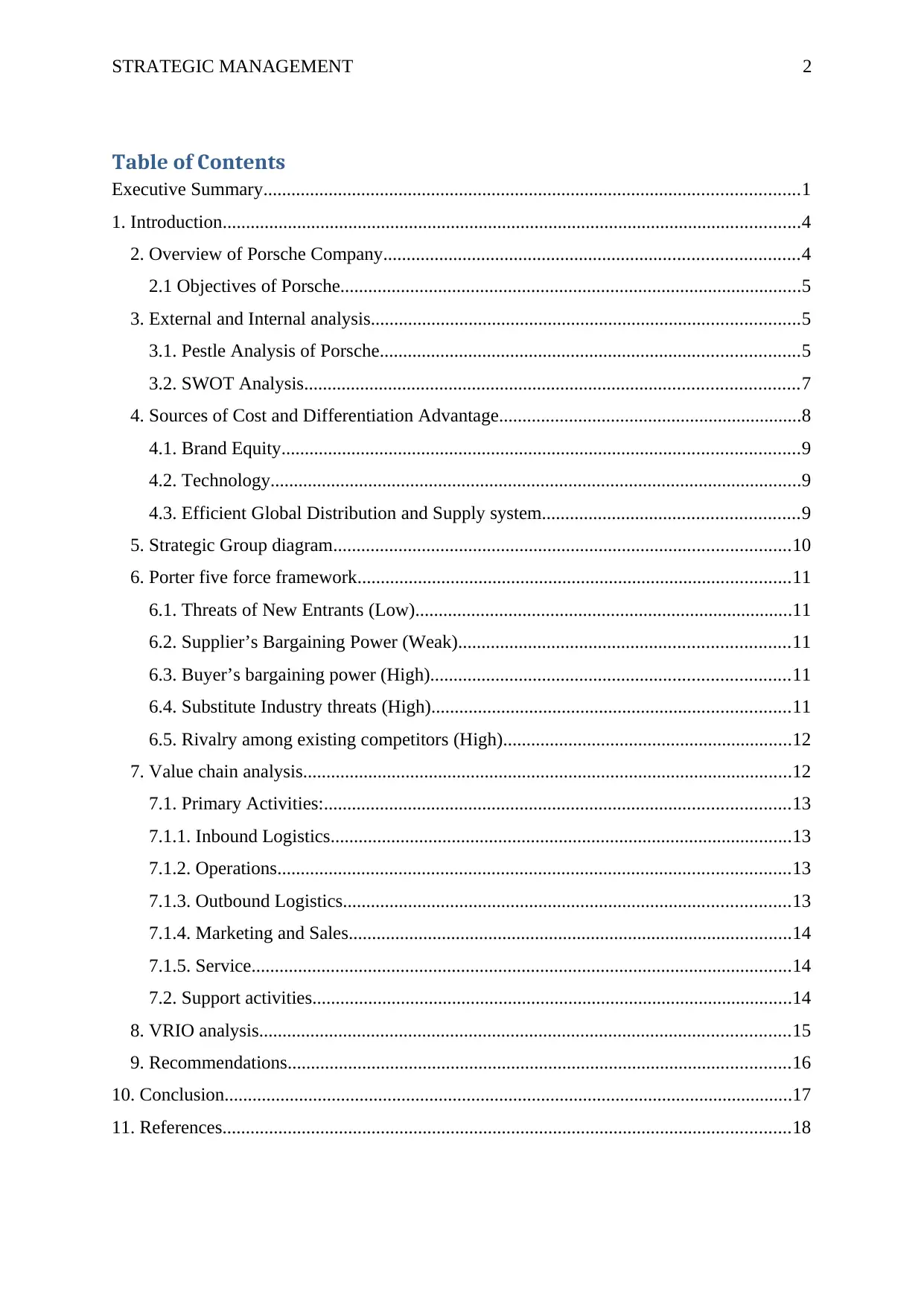
STRATEGIC MANAGEMENT 2
Table of Contents
Executive Summary...................................................................................................................1
1. Introduction............................................................................................................................4
2. Overview of Porsche Company.........................................................................................4
2.1 Objectives of Porsche...................................................................................................5
3. External and Internal analysis............................................................................................5
3.1. Pestle Analysis of Porsche..........................................................................................5
3.2. SWOT Analysis..........................................................................................................7
4. Sources of Cost and Differentiation Advantage.................................................................8
4.1. Brand Equity...............................................................................................................9
4.2. Technology..................................................................................................................9
4.3. Efficient Global Distribution and Supply system.......................................................9
5. Strategic Group diagram..................................................................................................10
6. Porter five force framework.............................................................................................11
6.1. Threats of New Entrants (Low).................................................................................11
6.2. Supplier’s Bargaining Power (Weak).......................................................................11
6.3. Buyer’s bargaining power (High).............................................................................11
6.4. Substitute Industry threats (High).............................................................................11
6.5. Rivalry among existing competitors (High)..............................................................12
7. Value chain analysis.........................................................................................................12
7.1. Primary Activities:....................................................................................................13
7.1.1. Inbound Logistics...................................................................................................13
7.1.2. Operations..............................................................................................................13
7.1.3. Outbound Logistics................................................................................................13
7.1.4. Marketing and Sales...............................................................................................14
7.1.5. Service....................................................................................................................14
7.2. Support activities.......................................................................................................14
8. VRIO analysis..................................................................................................................15
9. Recommendations............................................................................................................16
10. Conclusion..........................................................................................................................17
11. References..........................................................................................................................18
Table of Contents
Executive Summary...................................................................................................................1
1. Introduction............................................................................................................................4
2. Overview of Porsche Company.........................................................................................4
2.1 Objectives of Porsche...................................................................................................5
3. External and Internal analysis............................................................................................5
3.1. Pestle Analysis of Porsche..........................................................................................5
3.2. SWOT Analysis..........................................................................................................7
4. Sources of Cost and Differentiation Advantage.................................................................8
4.1. Brand Equity...............................................................................................................9
4.2. Technology..................................................................................................................9
4.3. Efficient Global Distribution and Supply system.......................................................9
5. Strategic Group diagram..................................................................................................10
6. Porter five force framework.............................................................................................11
6.1. Threats of New Entrants (Low).................................................................................11
6.2. Supplier’s Bargaining Power (Weak).......................................................................11
6.3. Buyer’s bargaining power (High).............................................................................11
6.4. Substitute Industry threats (High).............................................................................11
6.5. Rivalry among existing competitors (High)..............................................................12
7. Value chain analysis.........................................................................................................12
7.1. Primary Activities:....................................................................................................13
7.1.1. Inbound Logistics...................................................................................................13
7.1.2. Operations..............................................................................................................13
7.1.3. Outbound Logistics................................................................................................13
7.1.4. Marketing and Sales...............................................................................................14
7.1.5. Service....................................................................................................................14
7.2. Support activities.......................................................................................................14
8. VRIO analysis..................................................................................................................15
9. Recommendations............................................................................................................16
10. Conclusion..........................................................................................................................17
11. References..........................................................................................................................18
⊘ This is a preview!⊘
Do you want full access?
Subscribe today to unlock all pages.

Trusted by 1+ million students worldwide
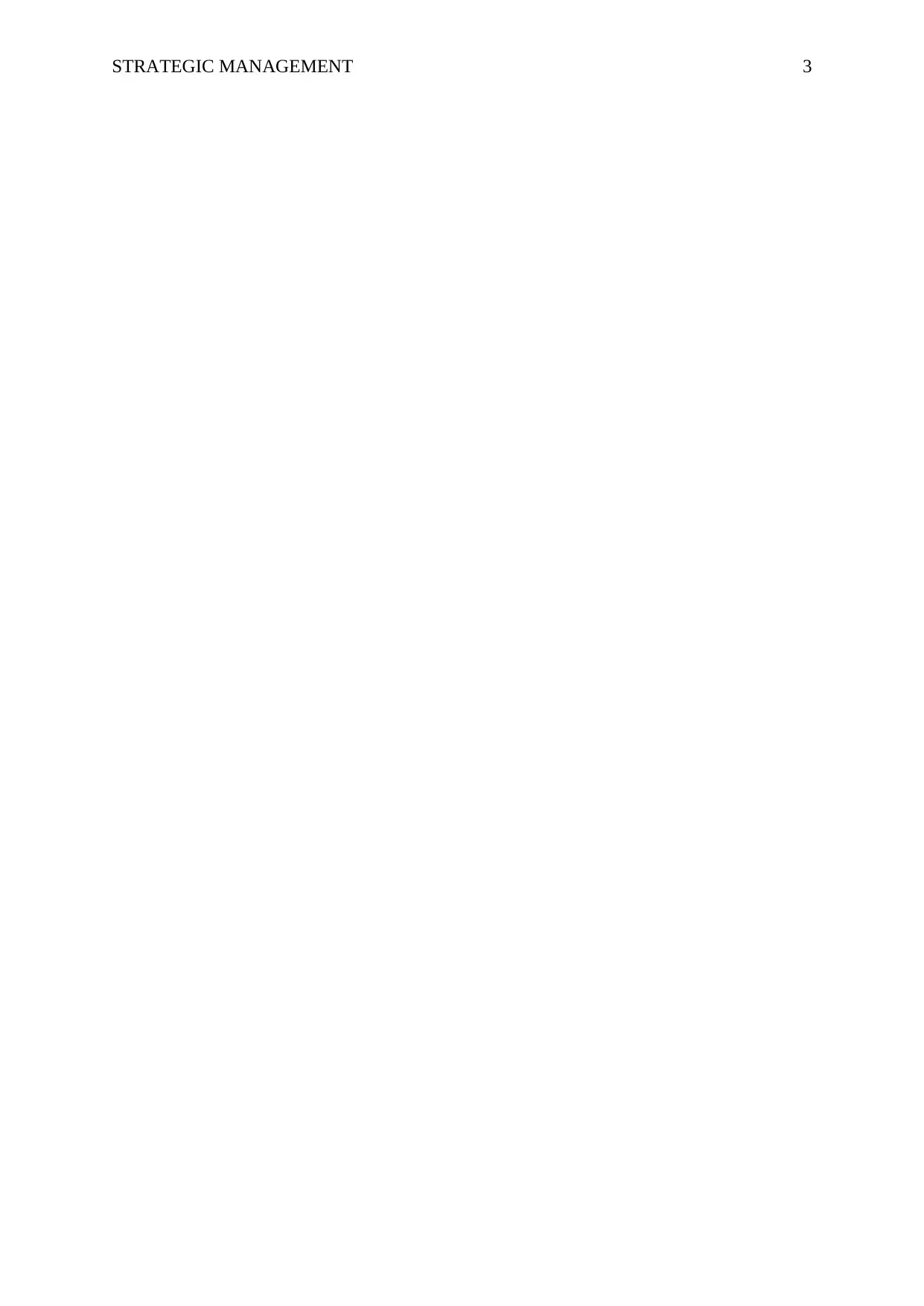
STRATEGIC MANAGEMENT 3
Paraphrase This Document
Need a fresh take? Get an instant paraphrase of this document with our AI Paraphraser
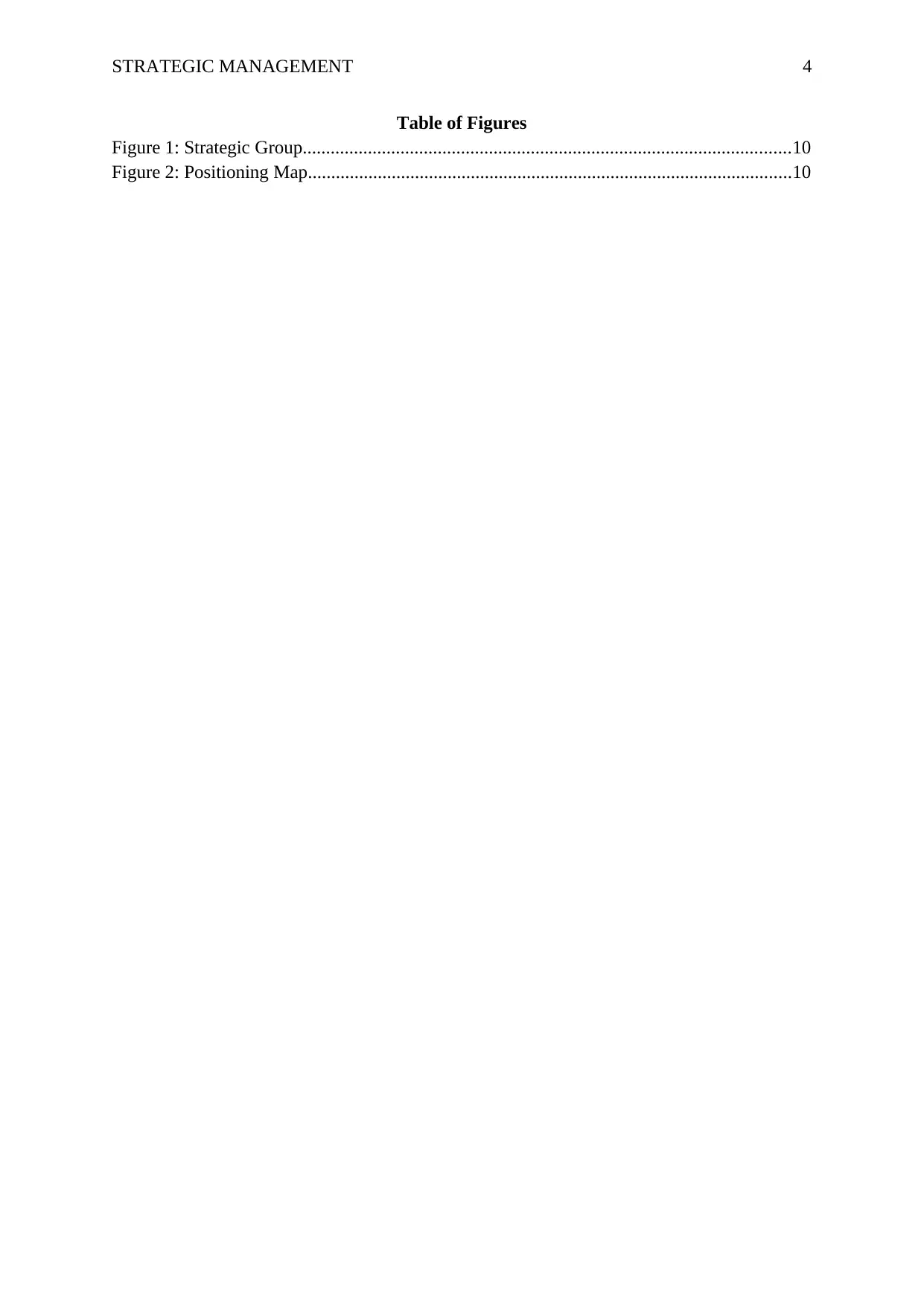
STRATEGIC MANAGEMENT 4
Table of Figures
Figure 1: Strategic Group.........................................................................................................10
Figure 2: Positioning Map........................................................................................................10
Table of Figures
Figure 1: Strategic Group.........................................................................................................10
Figure 2: Positioning Map........................................................................................................10
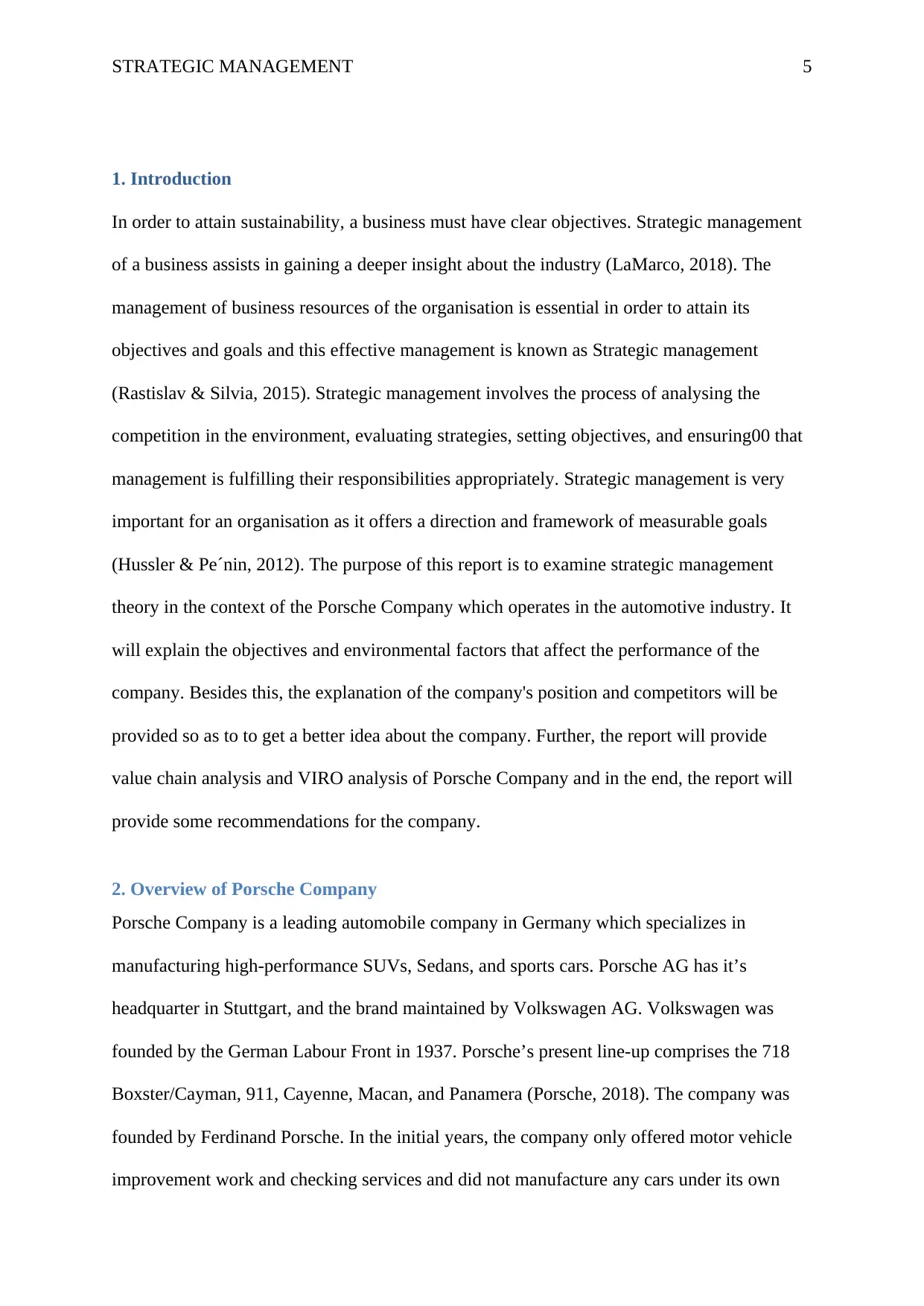
STRATEGIC MANAGEMENT 5
1. Introduction
In order to attain sustainability, a business must have clear objectives. Strategic management
of a business assists in gaining a deeper insight about the industry (LaMarco, 2018). The
management of business resources of the organisation is essential in order to attain its
objectives and goals and this effective management is known as Strategic management
(Rastislav & Silvia, 2015). Strategic management involves the process of analysing the
competition in the environment, evaluating strategies, setting objectives, and ensuring00 that
management is fulfilling their responsibilities appropriately. Strategic management is very
important for an organisation as it offers a direction and framework of measurable goals
(Hussler & Pe´nin, 2012). The purpose of this report is to examine strategic management
theory in the context of the Porsche Company which operates in the automotive industry. It
will explain the objectives and environmental factors that affect the performance of the
company. Besides this, the explanation of the company's position and competitors will be
provided so as to to get a better idea about the company. Further, the report will provide
value chain analysis and VIRO analysis of Porsche Company and in the end, the report will
provide some recommendations for the company.
2. Overview of Porsche Company
Porsche Company is a leading automobile company in Germany which specializes in
manufacturing high-performance SUVs, Sedans, and sports cars. Porsche AG has it’s
headquarter in Stuttgart, and the brand maintained by Volkswagen AG. Volkswagen was
founded by the German Labour Front in 1937. Porsche’s present line-up comprises the 718
Boxster/Cayman, 911, Cayenne, Macan, and Panamera (Porsche, 2018). The company was
founded by Ferdinand Porsche. In the initial years, the company only offered motor vehicle
improvement work and checking services and did not manufacture any cars under its own
1. Introduction
In order to attain sustainability, a business must have clear objectives. Strategic management
of a business assists in gaining a deeper insight about the industry (LaMarco, 2018). The
management of business resources of the organisation is essential in order to attain its
objectives and goals and this effective management is known as Strategic management
(Rastislav & Silvia, 2015). Strategic management involves the process of analysing the
competition in the environment, evaluating strategies, setting objectives, and ensuring00 that
management is fulfilling their responsibilities appropriately. Strategic management is very
important for an organisation as it offers a direction and framework of measurable goals
(Hussler & Pe´nin, 2012). The purpose of this report is to examine strategic management
theory in the context of the Porsche Company which operates in the automotive industry. It
will explain the objectives and environmental factors that affect the performance of the
company. Besides this, the explanation of the company's position and competitors will be
provided so as to to get a better idea about the company. Further, the report will provide
value chain analysis and VIRO analysis of Porsche Company and in the end, the report will
provide some recommendations for the company.
2. Overview of Porsche Company
Porsche Company is a leading automobile company in Germany which specializes in
manufacturing high-performance SUVs, Sedans, and sports cars. Porsche AG has it’s
headquarter in Stuttgart, and the brand maintained by Volkswagen AG. Volkswagen was
founded by the German Labour Front in 1937. Porsche’s present line-up comprises the 718
Boxster/Cayman, 911, Cayenne, Macan, and Panamera (Porsche, 2018). The company was
founded by Ferdinand Porsche. In the initial years, the company only offered motor vehicle
improvement work and checking services and did not manufacture any cars under its own
⊘ This is a preview!⊘
Do you want full access?
Subscribe today to unlock all pages.

Trusted by 1+ million students worldwide
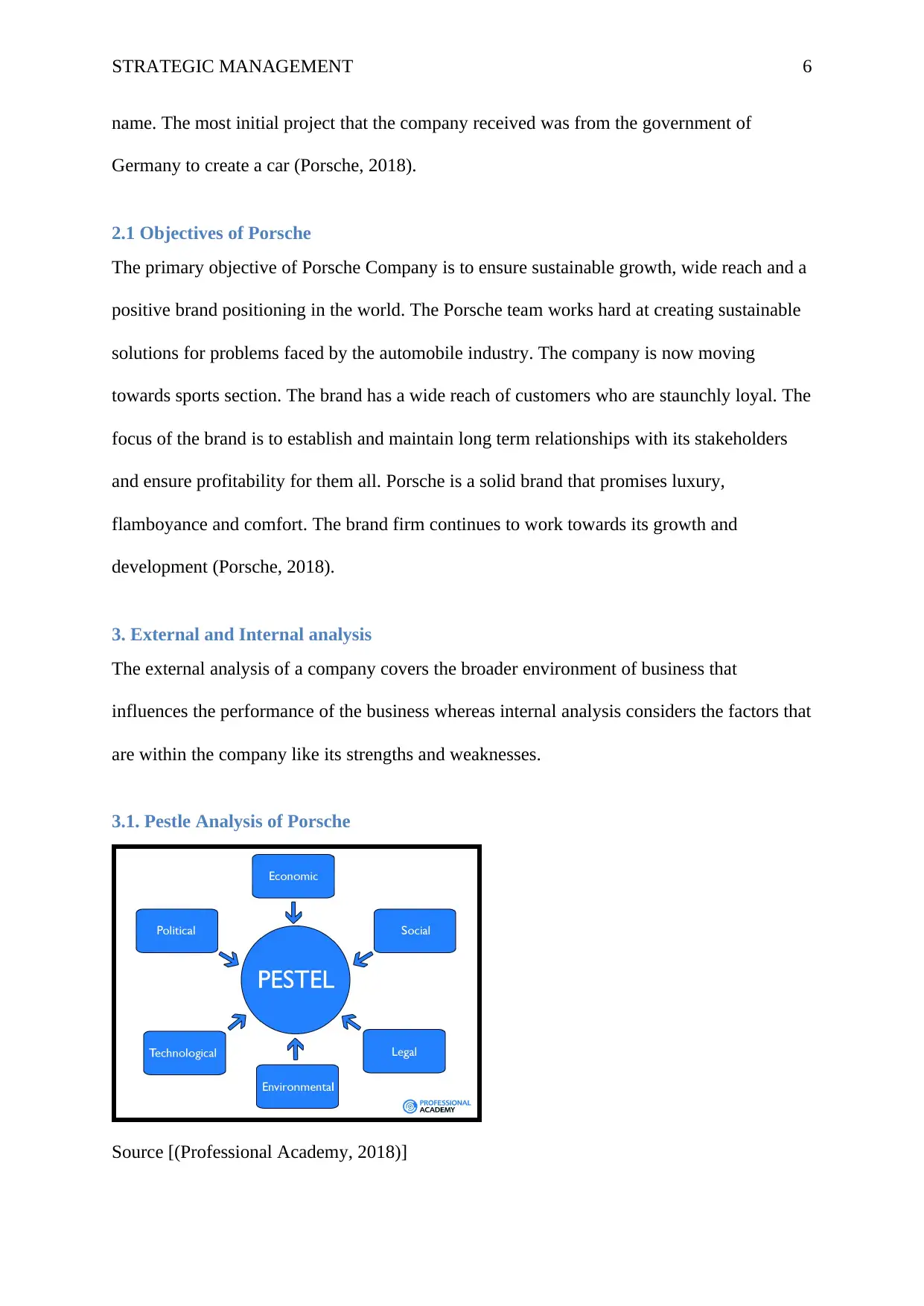
STRATEGIC MANAGEMENT 6
name. The most initial project that the company received was from the government of
Germany to create a car (Porsche, 2018).
2.1 Objectives of Porsche
The primary objective of Porsche Company is to ensure sustainable growth, wide reach and a
positive brand positioning in the world. The Porsche team works hard at creating sustainable
solutions for problems faced by the automobile industry. The company is now moving
towards sports section. The brand has a wide reach of customers who are staunchly loyal. The
focus of the brand is to establish and maintain long term relationships with its stakeholders
and ensure profitability for them all. Porsche is a solid brand that promises luxury,
flamboyance and comfort. The brand firm continues to work towards its growth and
development (Porsche, 2018).
3. External and Internal analysis
The external analysis of a company covers the broader environment of business that
influences the performance of the business whereas internal analysis considers the factors that
are within the company like its strengths and weaknesses.
3.1. Pestle Analysis of Porsche
Source [(Professional Academy, 2018)]
name. The most initial project that the company received was from the government of
Germany to create a car (Porsche, 2018).
2.1 Objectives of Porsche
The primary objective of Porsche Company is to ensure sustainable growth, wide reach and a
positive brand positioning in the world. The Porsche team works hard at creating sustainable
solutions for problems faced by the automobile industry. The company is now moving
towards sports section. The brand has a wide reach of customers who are staunchly loyal. The
focus of the brand is to establish and maintain long term relationships with its stakeholders
and ensure profitability for them all. Porsche is a solid brand that promises luxury,
flamboyance and comfort. The brand firm continues to work towards its growth and
development (Porsche, 2018).
3. External and Internal analysis
The external analysis of a company covers the broader environment of business that
influences the performance of the business whereas internal analysis considers the factors that
are within the company like its strengths and weaknesses.
3.1. Pestle Analysis of Porsche
Source [(Professional Academy, 2018)]
Paraphrase This Document
Need a fresh take? Get an instant paraphrase of this document with our AI Paraphraser
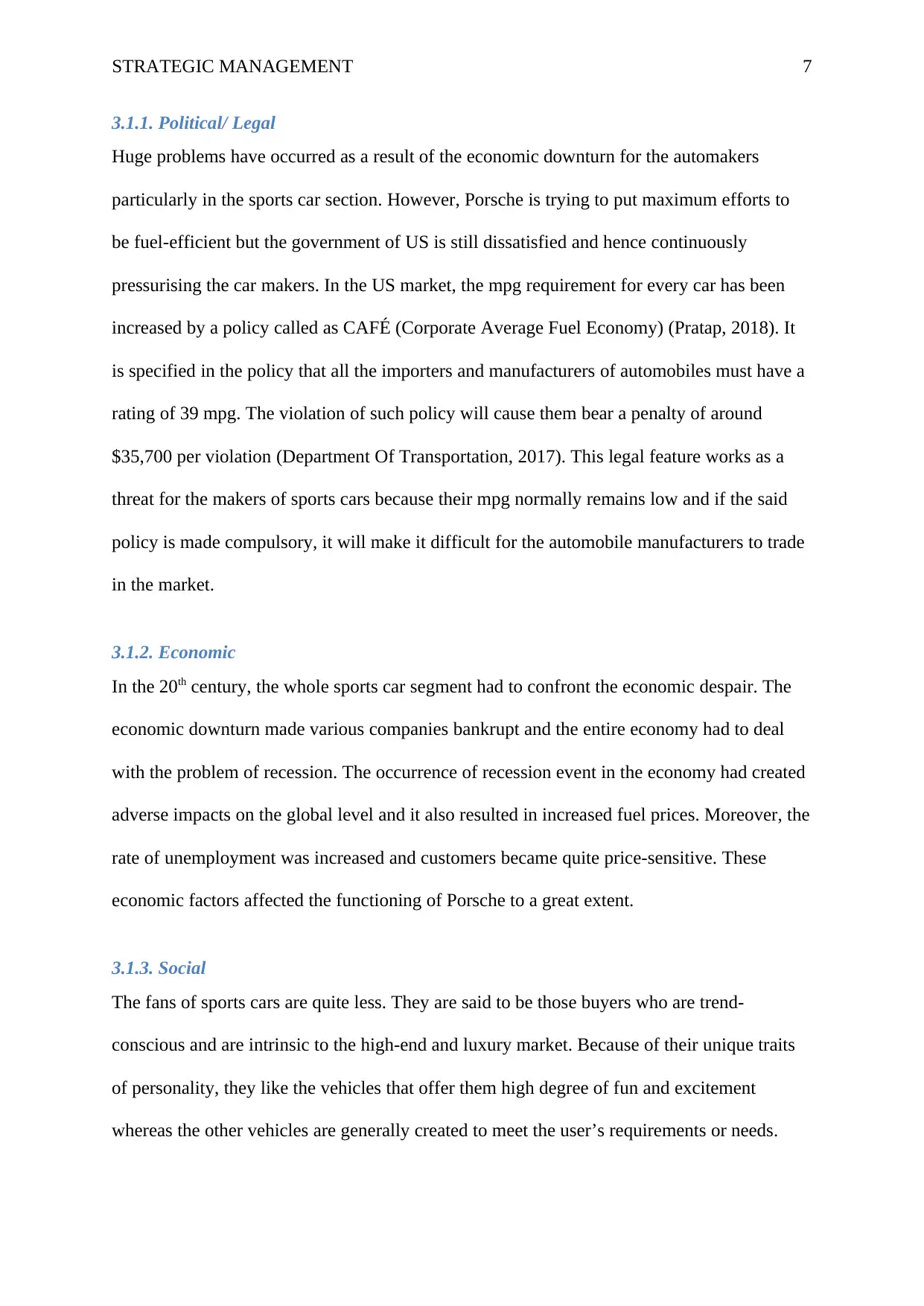
STRATEGIC MANAGEMENT 7
3.1.1. Political/ Legal
Huge problems have occurred as a result of the economic downturn for the automakers
particularly in the sports car section. However, Porsche is trying to put maximum efforts to
be fuel-efficient but the government of US is still dissatisfied and hence continuously
pressurising the car makers. In the US market, the mpg requirement for every car has been
increased by a policy called as CAFÉ (Corporate Average Fuel Economy) (Pratap, 2018). It
is specified in the policy that all the importers and manufacturers of automobiles must have a
rating of 39 mpg. The violation of such policy will cause them bear a penalty of around
$35,700 per violation (Department Of Transportation, 2017). This legal feature works as a
threat for the makers of sports cars because their mpg normally remains low and if the said
policy is made compulsory, it will make it difficult for the automobile manufacturers to trade
in the market.
3.1.2. Economic
In the 20th century, the whole sports car segment had to confront the economic despair. The
economic downturn made various companies bankrupt and the entire economy had to deal
with the problem of recession. The occurrence of recession event in the economy had created
adverse impacts on the global level and it also resulted in increased fuel prices. Moreover, the
rate of unemployment was increased and customers became quite price-sensitive. These
economic factors affected the functioning of Porsche to a great extent.
3.1.3. Social
The fans of sports cars are quite less. They are said to be those buyers who are trend-
conscious and are intrinsic to the high-end and luxury market. Because of their unique traits
of personality, they like the vehicles that offer them high degree of fun and excitement
whereas the other vehicles are generally created to meet the user’s requirements or needs.
3.1.1. Political/ Legal
Huge problems have occurred as a result of the economic downturn for the automakers
particularly in the sports car section. However, Porsche is trying to put maximum efforts to
be fuel-efficient but the government of US is still dissatisfied and hence continuously
pressurising the car makers. In the US market, the mpg requirement for every car has been
increased by a policy called as CAFÉ (Corporate Average Fuel Economy) (Pratap, 2018). It
is specified in the policy that all the importers and manufacturers of automobiles must have a
rating of 39 mpg. The violation of such policy will cause them bear a penalty of around
$35,700 per violation (Department Of Transportation, 2017). This legal feature works as a
threat for the makers of sports cars because their mpg normally remains low and if the said
policy is made compulsory, it will make it difficult for the automobile manufacturers to trade
in the market.
3.1.2. Economic
In the 20th century, the whole sports car segment had to confront the economic despair. The
economic downturn made various companies bankrupt and the entire economy had to deal
with the problem of recession. The occurrence of recession event in the economy had created
adverse impacts on the global level and it also resulted in increased fuel prices. Moreover, the
rate of unemployment was increased and customers became quite price-sensitive. These
economic factors affected the functioning of Porsche to a great extent.
3.1.3. Social
The fans of sports cars are quite less. They are said to be those buyers who are trend-
conscious and are intrinsic to the high-end and luxury market. Because of their unique traits
of personality, they like the vehicles that offer them high degree of fun and excitement
whereas the other vehicles are generally created to meet the user’s requirements or needs.
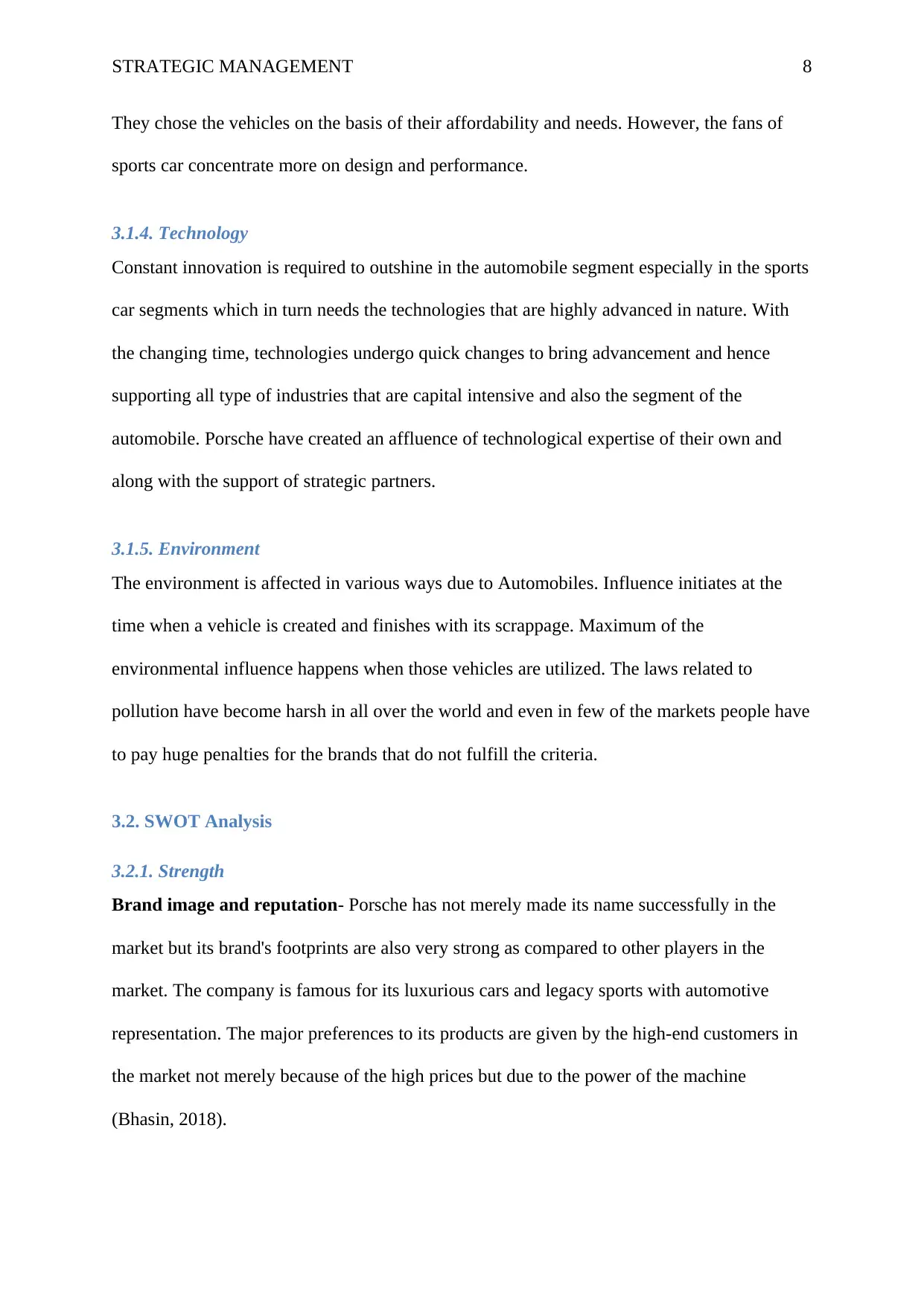
STRATEGIC MANAGEMENT 8
They chose the vehicles on the basis of their affordability and needs. However, the fans of
sports car concentrate more on design and performance.
3.1.4. Technology
Constant innovation is required to outshine in the automobile segment especially in the sports
car segments which in turn needs the technologies that are highly advanced in nature. With
the changing time, technologies undergo quick changes to bring advancement and hence
supporting all type of industries that are capital intensive and also the segment of the
automobile. Porsche have created an affluence of technological expertise of their own and
along with the support of strategic partners.
3.1.5. Environment
The environment is affected in various ways due to Automobiles. Influence initiates at the
time when a vehicle is created and finishes with its scrappage. Maximum of the
environmental influence happens when those vehicles are utilized. The laws related to
pollution have become harsh in all over the world and even in few of the markets people have
to pay huge penalties for the brands that do not fulfill the criteria.
3.2. SWOT Analysis
3.2.1. Strength
Brand image and reputation- Porsche has not merely made its name successfully in the
market but its brand's footprints are also very strong as compared to other players in the
market. The company is famous for its luxurious cars and legacy sports with automotive
representation. The major preferences to its products are given by the high-end customers in
the market not merely because of the high prices but due to the power of the machine
(Bhasin, 2018).
They chose the vehicles on the basis of their affordability and needs. However, the fans of
sports car concentrate more on design and performance.
3.1.4. Technology
Constant innovation is required to outshine in the automobile segment especially in the sports
car segments which in turn needs the technologies that are highly advanced in nature. With
the changing time, technologies undergo quick changes to bring advancement and hence
supporting all type of industries that are capital intensive and also the segment of the
automobile. Porsche have created an affluence of technological expertise of their own and
along with the support of strategic partners.
3.1.5. Environment
The environment is affected in various ways due to Automobiles. Influence initiates at the
time when a vehicle is created and finishes with its scrappage. Maximum of the
environmental influence happens when those vehicles are utilized. The laws related to
pollution have become harsh in all over the world and even in few of the markets people have
to pay huge penalties for the brands that do not fulfill the criteria.
3.2. SWOT Analysis
3.2.1. Strength
Brand image and reputation- Porsche has not merely made its name successfully in the
market but its brand's footprints are also very strong as compared to other players in the
market. The company is famous for its luxurious cars and legacy sports with automotive
representation. The major preferences to its products are given by the high-end customers in
the market not merely because of the high prices but due to the power of the machine
(Bhasin, 2018).
⊘ This is a preview!⊘
Do you want full access?
Subscribe today to unlock all pages.

Trusted by 1+ million students worldwide
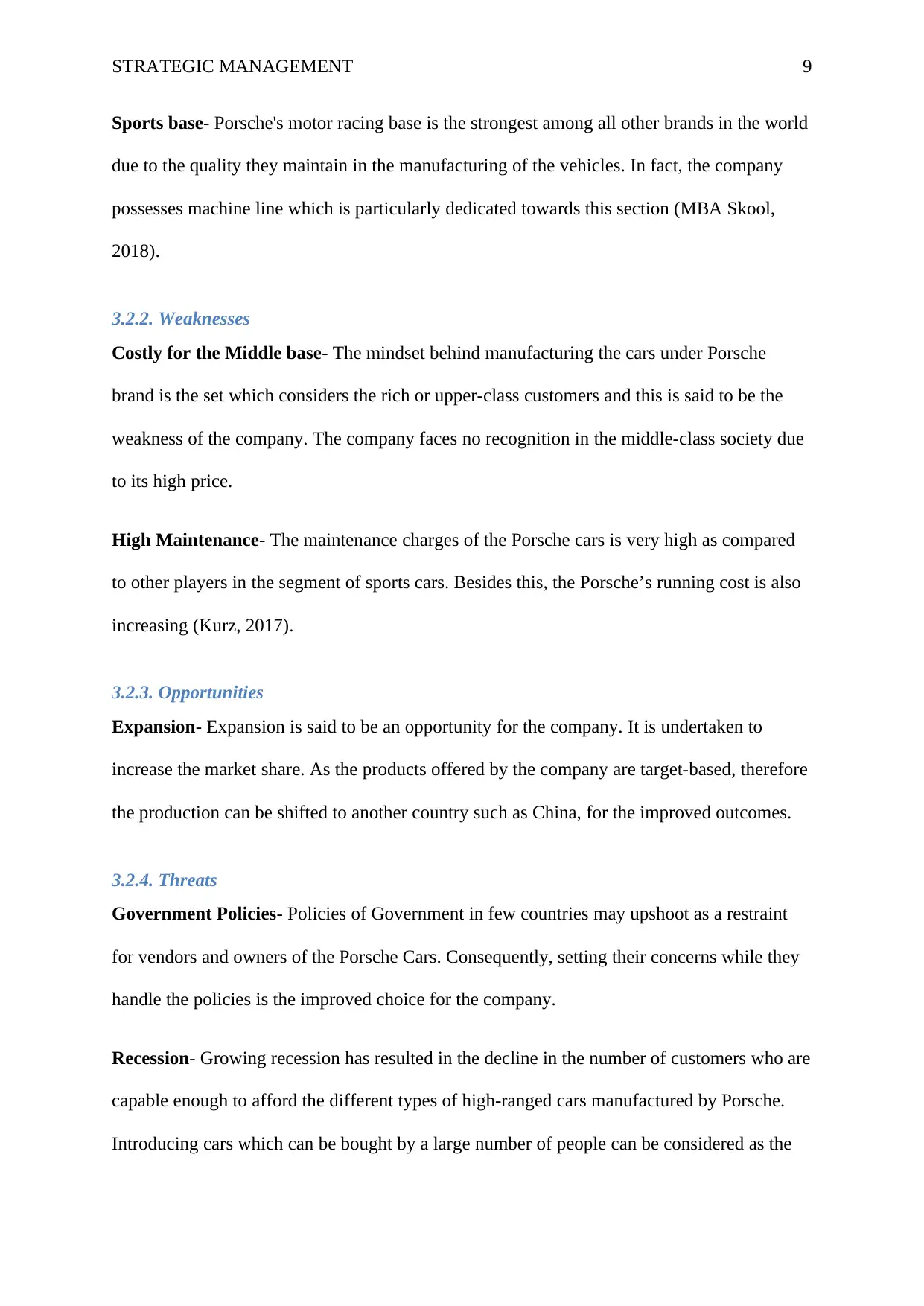
STRATEGIC MANAGEMENT 9
Sports base- Porsche's motor racing base is the strongest among all other brands in the world
due to the quality they maintain in the manufacturing of the vehicles. In fact, the company
possesses machine line which is particularly dedicated towards this section (MBA Skool,
2018).
3.2.2. Weaknesses
Costly for the Middle base- The mindset behind manufacturing the cars under Porsche
brand is the set which considers the rich or upper-class customers and this is said to be the
weakness of the company. The company faces no recognition in the middle-class society due
to its high price.
High Maintenance- The maintenance charges of the Porsche cars is very high as compared
to other players in the segment of sports cars. Besides this, the Porsche’s running cost is also
increasing (Kurz, 2017).
3.2.3. Opportunities
Expansion- Expansion is said to be an opportunity for the company. It is undertaken to
increase the market share. As the products offered by the company are target-based, therefore
the production can be shifted to another country such as China, for the improved outcomes.
3.2.4. Threats
Government Policies- Policies of Government in few countries may upshoot as a restraint
for vendors and owners of the Porsche Cars. Consequently, setting their concerns while they
handle the policies is the improved choice for the company.
Recession- Growing recession has resulted in the decline in the number of customers who are
capable enough to afford the different types of high-ranged cars manufactured by Porsche.
Introducing cars which can be bought by a large number of people can be considered as the
Sports base- Porsche's motor racing base is the strongest among all other brands in the world
due to the quality they maintain in the manufacturing of the vehicles. In fact, the company
possesses machine line which is particularly dedicated towards this section (MBA Skool,
2018).
3.2.2. Weaknesses
Costly for the Middle base- The mindset behind manufacturing the cars under Porsche
brand is the set which considers the rich or upper-class customers and this is said to be the
weakness of the company. The company faces no recognition in the middle-class society due
to its high price.
High Maintenance- The maintenance charges of the Porsche cars is very high as compared
to other players in the segment of sports cars. Besides this, the Porsche’s running cost is also
increasing (Kurz, 2017).
3.2.3. Opportunities
Expansion- Expansion is said to be an opportunity for the company. It is undertaken to
increase the market share. As the products offered by the company are target-based, therefore
the production can be shifted to another country such as China, for the improved outcomes.
3.2.4. Threats
Government Policies- Policies of Government in few countries may upshoot as a restraint
for vendors and owners of the Porsche Cars. Consequently, setting their concerns while they
handle the policies is the improved choice for the company.
Recession- Growing recession has resulted in the decline in the number of customers who are
capable enough to afford the different types of high-ranged cars manufactured by Porsche.
Introducing cars which can be bought by a large number of people can be considered as the
Paraphrase This Document
Need a fresh take? Get an instant paraphrase of this document with our AI Paraphraser
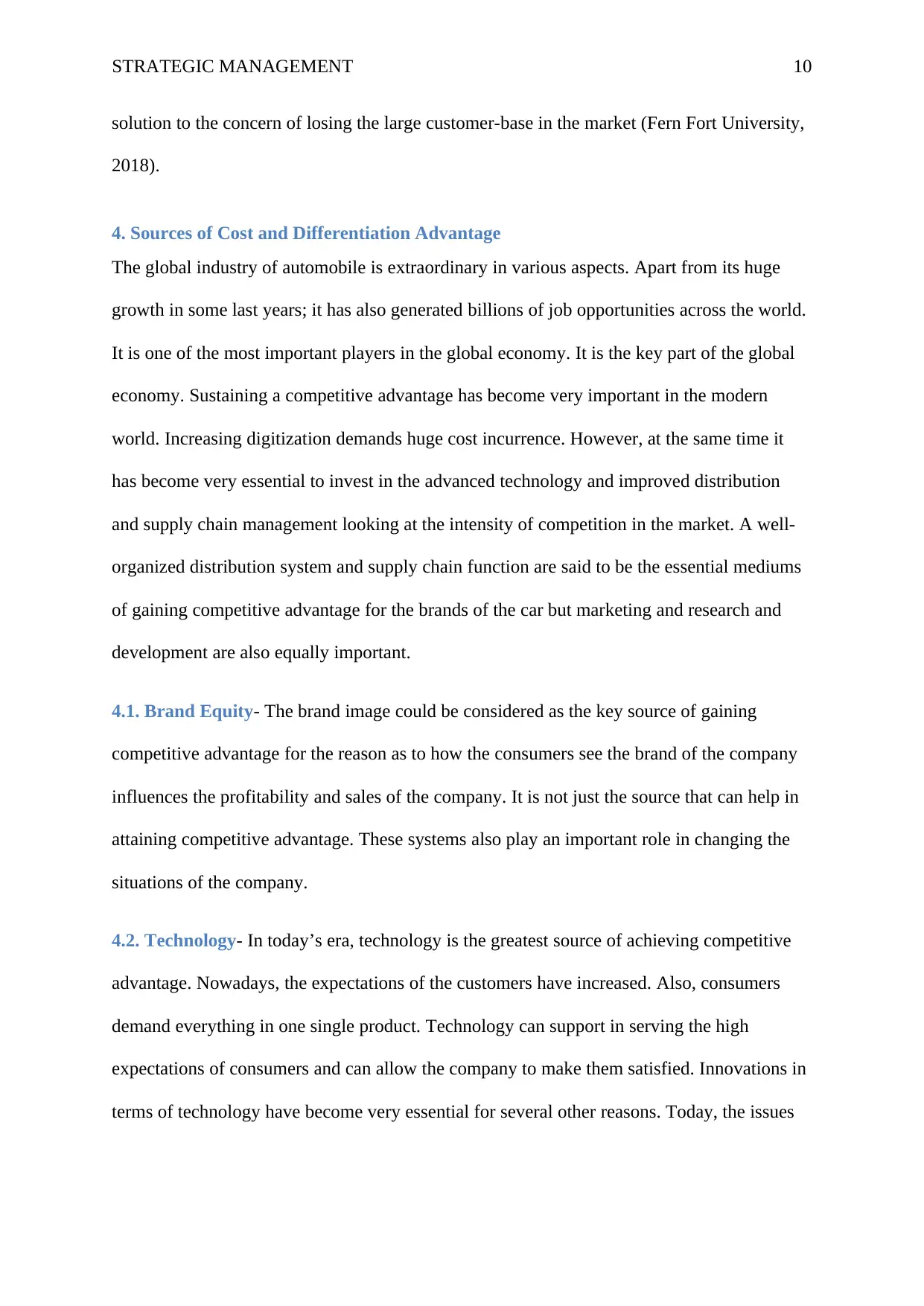
STRATEGIC MANAGEMENT 10
solution to the concern of losing the large customer-base in the market (Fern Fort University,
2018).
4. Sources of Cost and Differentiation Advantage
The global industry of automobile is extraordinary in various aspects. Apart from its huge
growth in some last years; it has also generated billions of job opportunities across the world.
It is one of the most important players in the global economy. It is the key part of the global
economy. Sustaining a competitive advantage has become very important in the modern
world. Increasing digitization demands huge cost incurrence. However, at the same time it
has become very essential to invest in the advanced technology and improved distribution
and supply chain management looking at the intensity of competition in the market. A well-
organized distribution system and supply chain function are said to be the essential mediums
of gaining competitive advantage for the brands of the car but marketing and research and
development are also equally important.
4.1. Brand Equity- The brand image could be considered as the key source of gaining
competitive advantage for the reason as to how the consumers see the brand of the company
influences the profitability and sales of the company. It is not just the source that can help in
attaining competitive advantage. These systems also play an important role in changing the
situations of the company.
4.2. Technology- In today’s era, technology is the greatest source of achieving competitive
advantage. Nowadays, the expectations of the customers have increased. Also, consumers
demand everything in one single product. Technology can support in serving the high
expectations of consumers and can allow the company to make them satisfied. Innovations in
terms of technology have become very essential for several other reasons. Today, the issues
solution to the concern of losing the large customer-base in the market (Fern Fort University,
2018).
4. Sources of Cost and Differentiation Advantage
The global industry of automobile is extraordinary in various aspects. Apart from its huge
growth in some last years; it has also generated billions of job opportunities across the world.
It is one of the most important players in the global economy. It is the key part of the global
economy. Sustaining a competitive advantage has become very important in the modern
world. Increasing digitization demands huge cost incurrence. However, at the same time it
has become very essential to invest in the advanced technology and improved distribution
and supply chain management looking at the intensity of competition in the market. A well-
organized distribution system and supply chain function are said to be the essential mediums
of gaining competitive advantage for the brands of the car but marketing and research and
development are also equally important.
4.1. Brand Equity- The brand image could be considered as the key source of gaining
competitive advantage for the reason as to how the consumers see the brand of the company
influences the profitability and sales of the company. It is not just the source that can help in
attaining competitive advantage. These systems also play an important role in changing the
situations of the company.
4.2. Technology- In today’s era, technology is the greatest source of achieving competitive
advantage. Nowadays, the expectations of the customers have increased. Also, consumers
demand everything in one single product. Technology can support in serving the high
expectations of consumers and can allow the company to make them satisfied. Innovations in
terms of technology have become very essential for several other reasons. Today, the issues
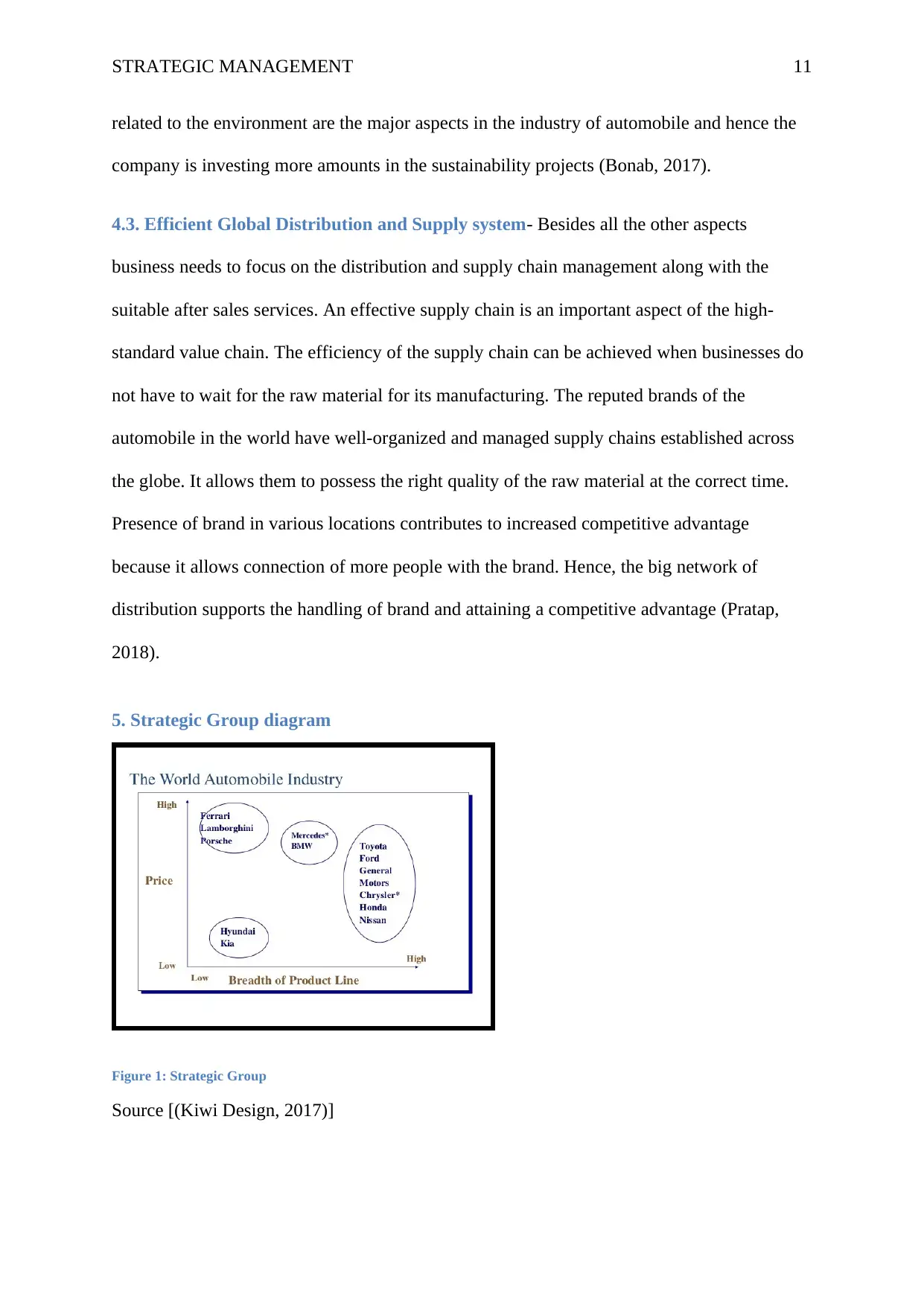
STRATEGIC MANAGEMENT 11
related to the environment are the major aspects in the industry of automobile and hence the
company is investing more amounts in the sustainability projects (Bonab, 2017).
4.3. Efficient Global Distribution and Supply system- Besides all the other aspects
business needs to focus on the distribution and supply chain management along with the
suitable after sales services. An effective supply chain is an important aspect of the high-
standard value chain. The efficiency of the supply chain can be achieved when businesses do
not have to wait for the raw material for its manufacturing. The reputed brands of the
automobile in the world have well-organized and managed supply chains established across
the globe. It allows them to possess the right quality of the raw material at the correct time.
Presence of brand in various locations contributes to increased competitive advantage
because it allows connection of more people with the brand. Hence, the big network of
distribution supports the handling of brand and attaining a competitive advantage (Pratap,
2018).
5. Strategic Group diagram
Figure 1: Strategic Group
Source [(Kiwi Design, 2017)]
related to the environment are the major aspects in the industry of automobile and hence the
company is investing more amounts in the sustainability projects (Bonab, 2017).
4.3. Efficient Global Distribution and Supply system- Besides all the other aspects
business needs to focus on the distribution and supply chain management along with the
suitable after sales services. An effective supply chain is an important aspect of the high-
standard value chain. The efficiency of the supply chain can be achieved when businesses do
not have to wait for the raw material for its manufacturing. The reputed brands of the
automobile in the world have well-organized and managed supply chains established across
the globe. It allows them to possess the right quality of the raw material at the correct time.
Presence of brand in various locations contributes to increased competitive advantage
because it allows connection of more people with the brand. Hence, the big network of
distribution supports the handling of brand and attaining a competitive advantage (Pratap,
2018).
5. Strategic Group diagram
Figure 1: Strategic Group
Source [(Kiwi Design, 2017)]
⊘ This is a preview!⊘
Do you want full access?
Subscribe today to unlock all pages.

Trusted by 1+ million students worldwide
1 out of 23
Related Documents
Your All-in-One AI-Powered Toolkit for Academic Success.
+13062052269
info@desklib.com
Available 24*7 on WhatsApp / Email
![[object Object]](/_next/static/media/star-bottom.7253800d.svg)
Unlock your academic potential
Copyright © 2020–2025 A2Z Services. All Rights Reserved. Developed and managed by ZUCOL.




